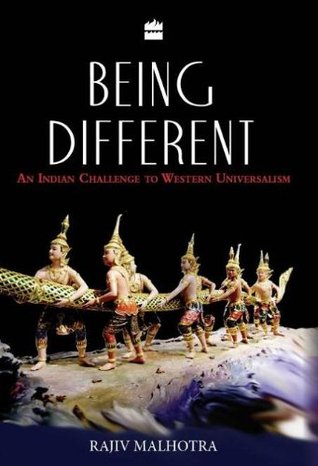More on this book
Kindle Notes & Highlights
I want all the cultures of all lands to be blown about my house as freely as possible. But I refuse to be blown off my feet by any. – Gandhi
Dharma and Judeo-Christian traditions differ fundamentally in their approaches to knowing the divine. The dharma family (including Hinduism, Buddhism, Sikhism and Jainism) has developed an extensive range of inner sciences and experiential technologies called 'adhyatmavidya' to access divinity and higher states of consciousness.
They are neither a code of laws nor a history of past revelations but guides for replicating and retransmitting the experience and its transformational powers.
All dharmic schools begin by assuming that ultimately the cosmos is a unified whole in which absolute reality and the relative manifestations are profoundly connected. Western worldviews, by contrast, have been shaped by a tension between the absolute status of Judeo-Christian historical revelations on the one hand and the knowledge produced by a highly dualistic and atomistic Greek metaphysics and Aristotelian binary logic on the other.
The Hindu delegation, led by Swami Dayananda Saraswati of the Hindu Dharma Acharya Sabha, had insisted that the term 'tolerance' in the draft be replaced with 'mutual respect'. However, the then representative of the Vatican, Cardinal Joseph Ratzinger, who is now Pope Benedict, had put his foot down in opposition to such a phrase. After all, if religions deemed 'heathen' were to start getting officially respected, there would be no justification for evangelizing and converting their adherents to Christianity. This would undermine the exclusive claims of Christianity which form the
...more
religions to be formally respected as equals and not just tolerated by the 'religions of the book' (i.e., the three Abrahamic religions).
I explained that in Hinduism there was no injunction against worshipping images of the divine (what the Abrahamic religions routinely and wrongly condemn as 'idolatry'). Indeed, I use images myself in my spiritual practice and felt glad that she had agreed to respect this practice.
Many Hindus are either not knowledgeable about theological matters or too timid to probe, which in turn makes them susceptible to the sameness argument. Deception may not have been the goal of the Lutheran delegation, but it is a matter of record that disingenuous preachers in India have often used the pretence of sameness as a ploy to disarm and eventually convert others.
As a way of resolving difference, Western civilization is given to isolating the elements of other civilizations and placing them in its own conceptual categories – categories formulated by the 'white', 'Christian', and 'progressive' race. This categorization privileges the Western gaze and enables it to declare itself as the universal norm for others to emulate. It is a system for gaining control. On the flip side, many raised in dharmic cultures suffer anxieties related to being non-white, non-Western, non-Christian, and so on. Their identities are enhanced by imagining themselves in the
...more
Indian traditions embody the approach of difference with mutual respect based on the radical idea that differences are not a problem to be solved. Differences are merely characteristic of the way things naturally are, and comfort with them is built into dharmic world views – views which encompass 'chaos', doubt and numerous other complexities.
Indian mathematical concepts of infinitesimal, infinity and infinite series were quarantined in Europe for more than a century as they were seen as heretical and threatening to the finite and controllable cosmos of the Bible.
Roman Catholic Church under the rubric of 'inculturation'. The term was first used to describe efforts to indoctrinate and proselytize societies outside the Jerusalem–Rome axis. Rather than risk replacing an entire way of life with another, missionaries cunningly allowed the natives to retain their cultural identities and practices while replacing their deities with Jesus and asserting that the Church was the ultimate authority on spirituality.
Ramakrishnan liked this
In the case of Hinduism, the Hindu aspects are downplayed and the Christian aspects emphasized. This is done carefully after ensuring that the link with Hinduism is sufficiently softened and that the person's dependency on the missionaries is strong. Hinduism is not yet denigrated openly, but caste, dowry, female 'abuses' and other examples of 'backwardness' are emphasized as the defining qualities. In the final stage, Hinduism is openly blasted, and the person is turned into a solid Christian. It is only after analysing the long-term implications of this transformation that the treachery
...more
'Roman Brahmin', de Nobili had no qualms about faking his personal genealogy to bolster his authority – even to the point of claiming direct descent from Brahma! He even produced an authoritative 'fifth Veda' in which he proclaimed the truths of Christianity. By associating his Christianized Hinduism
Over time the Catholic Church expanded its policy of inculturation to accommodate not just non-Christian cultural symbols but also non-Christian religious sentiments. For instance, in 1939 Pope Pius XII reversed a long-standing Vatican injunction against the Chinese Christian custom of ancestor worship, declaring that this was not superstition but an honourable way of remembering ancestors. This type of inculturation pretends respect for other faiths while in fact seeking to prepare them for conversion.
At least a hundred quotations from the Vedas, the Yoga Sutras and the Upanishads have been incorporated into the 'Indian Bible' published by the Roman Catholic Church in 2008.


